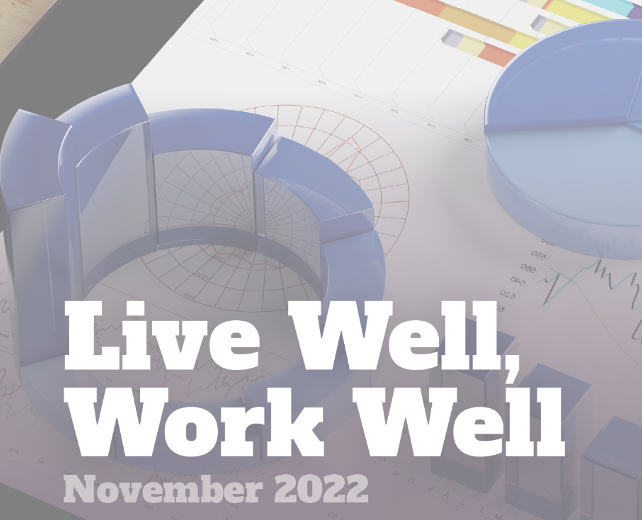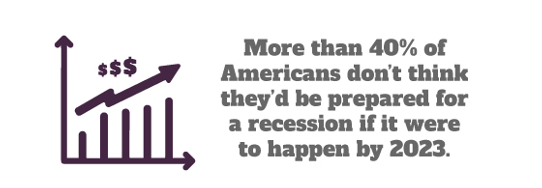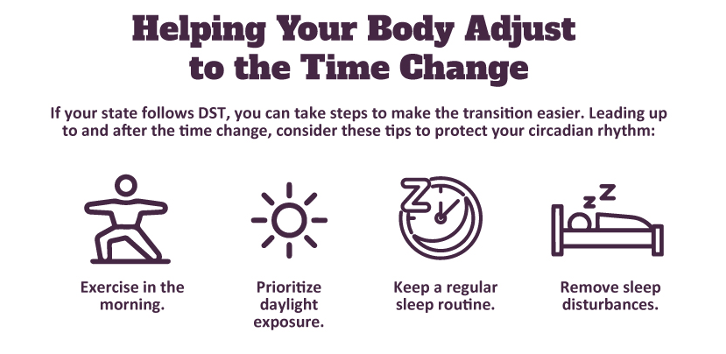
How to Recession-proof Your Life
Many Americans and economists think rising inflation issues, interest rates and housing costs may be warning signs of a looming recession. According to a Bankrate poll, nearly 7 in 10 Americans are worried about the possibility of a recession before the end of next year. Unfortunately, many Americans don’t feel prepared for an economic downturn.

Predictions about an official recession occurring are divided. Regardless, you can take the following steps to prepare or stabilize your funds:
- Understand your expenses by examining and assessing your current financials, paying close attention to savings opportunities.
- Adjust your budget to plan for everyday and large purchases and stick to it. Remember to keep it realistic.
- Make it a habit to live within your means. People who adopt this lifestyle are less likely to go into debt and can pivot their spending to compensate for changes.
- Build an emergency savings fund—specifically, at least three to six months’ worth of living expenses—to pay for unexpected costs.
- Switch up your grocery spending by shopping with a meal plan, buying generic products rather than brand-name or purchasing items in bulk.
- Negotiate your monthly bills (e.g., utilities, phone and internet) or ask about discounts or coupons.
- Consolidate your loans and pay off as much of your debt as possible.
- Secure proper insurance (e.g., auto, homeowners, health and life) to help maintain financial protection amid unexpected losses.
To deal with economic uncertainty, focus on developing healthy financial habits for today and the future. In addition, consider discussing your situation with a financial advisor. Speak to your employer if you need further financial resources.

Makes: 12 servings
Ingredients
12 jumbo pasta shells
1 ¼ cups part-skim ricotta cheese
¾ cup pumpkin puree
½ tsp. garlic powder
2 Tbsp. fresh basil (chopped)
¼ tsp. dried sage
½ tsp. salt
½ tsp. black pepper
½ cup grated Parmesan cheese, divided
1 cup low-sodium spaghetti sauce
Preparations
- Preheat the oven to 350 F.
- Cook the pasta shells according to package directions. Drain and place the shells on a baking sheet to cool.
- In a bowl, stir together the ricotta cheese, pumpkin puree, spices and all but 1 Tbsp. of the Parmesan cheese.
- Spread the spaghetti sauce in the bottom of a baking dish that can hold all the pasta shells in a single layer.
- Fill each pasta shell with about 3 Tbsp. of the pumpkin mixture and place the shells close together within the sauced baking dish.
- Cover the baking dish with foil and bake for 30 minutes.
- Remove the foil from the baking dish, sprinkle the pasta shells with the remaining Parmesan cheese and bake for 15 more minutes. Serve and enjoy.
Nutritional Information
(per serving)
| Total calories | 103 |
| Total fat | 4 g |
| Protein | 6 g |
| Sodium | 211 mg |
| Carbohydrate | 12 g |
| Dietary fiber | 1 g |
| Saturated fat | 2 g |
| Total sugars | 2 g |
Source: MyPlate
Daylight Saving Time and Your Health
Most of the United States shifts between standard and daylight saving time (DST) each year in an effort to “save” natural light. Clocks will get set one hour back on Sunday, Nov. 6, when the DST period ends. Although you may be excited about gaining another hour in your day, DST can wreak havoc on your physical and cognitive health for several days, weeks or even months.
The disruption of DST can negatively impact your health. Your internal clock regulates critical processes, including liver function and the immune system. Interruptions to the circadian rhythm, your body’s 24-hour biological cycle that regulates wake and sleep, can also impair your focus and judgment. For example, a study published in Current Biology found fatal U.S. traffic accidents increased by 6% in the week following DST. Fortunately, there are ways to increase your odds of a smooth DST transition.
While you may be tempted to use the extra hour to indulge in various activities, health experts recommend using that time for sleep. To help make the DST transition easier, consider going to bed 15-20 minutes early in the days beforehand to help your body get used to the difference. If you have specific health concerns, talk to your doctor.

November Is American Diabetes Month
According to the Centers for Disease Control and Prevention, more than 37 million American adults have diabetes, and 1 in 5 don’t even know they have it. While Type 1 diabetes can’t be prevented, you can take the following steps to prevent Type 2 diabetes:
- Eat a balanced diet. Consume plenty of fiber and whole grains, and understand how the foods you eat affect your blood sugar levels.
- Stay active. Aim for at least 30 minutes of exercise daily. Incorporate both aerobic and resistance training.
- Maintain a healthy weight. If you’re overweight, weight control can be an essential part of diabetes prevention.
In the last 20 years, the number of adults diagnosed with diabetes has more than doubled. Take control now during American Diabetes Month, and have your blood sugar levels tested by your doctor.
For more information on Capital Services, scan below!





